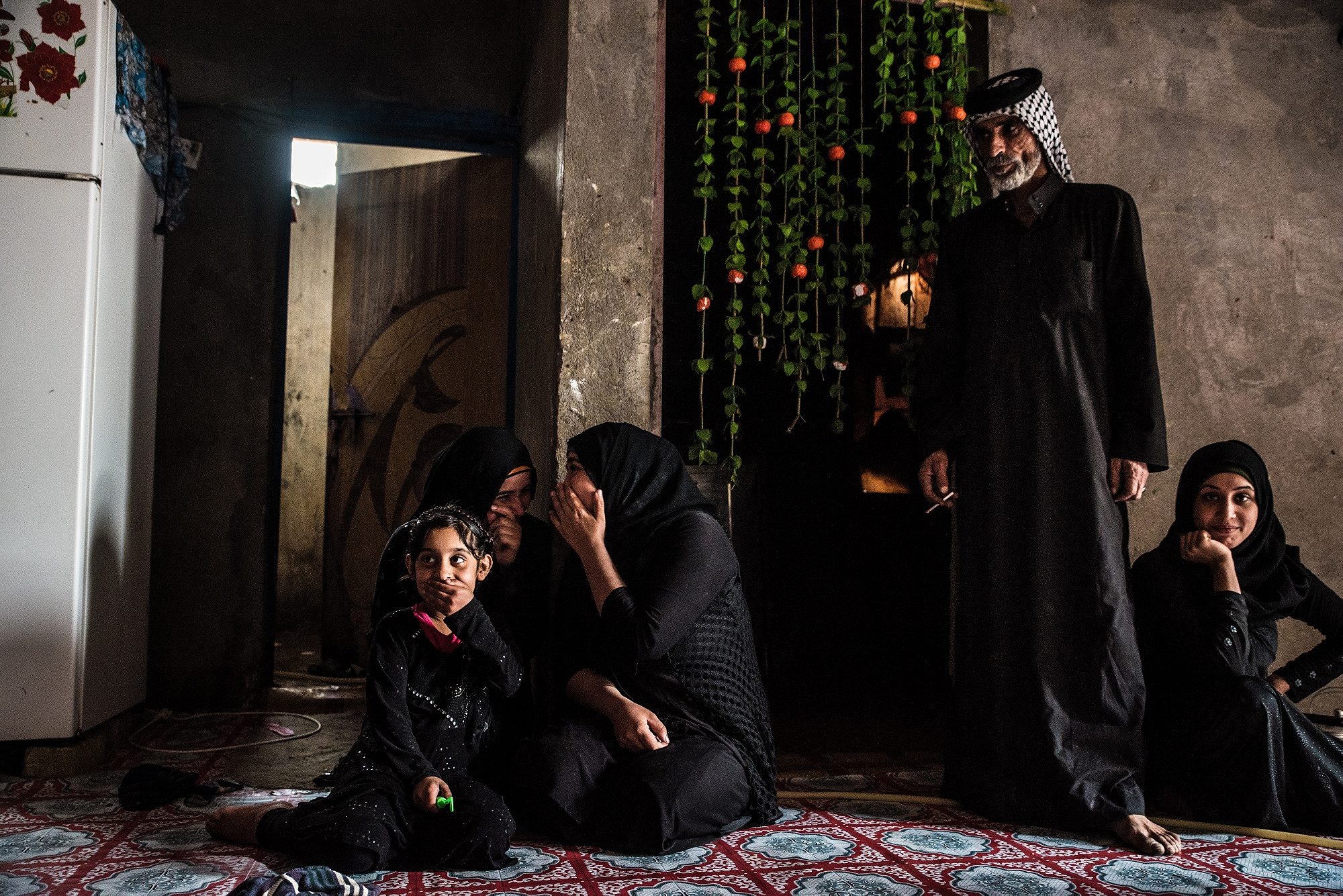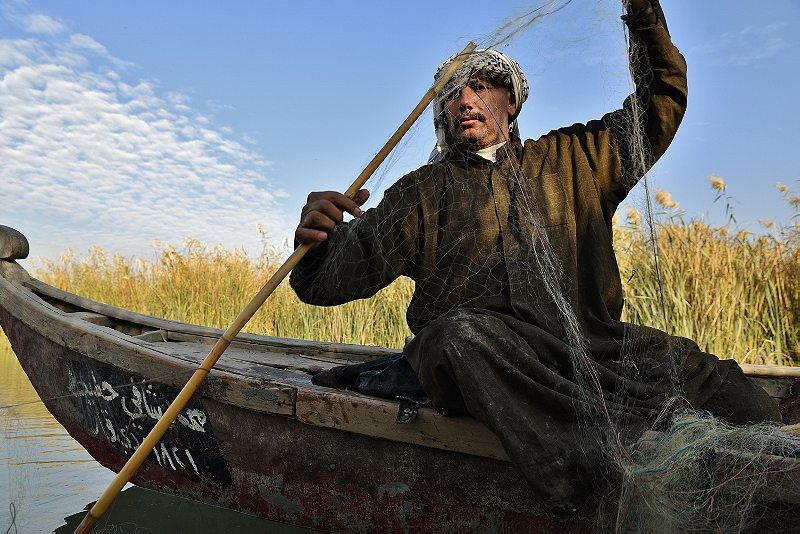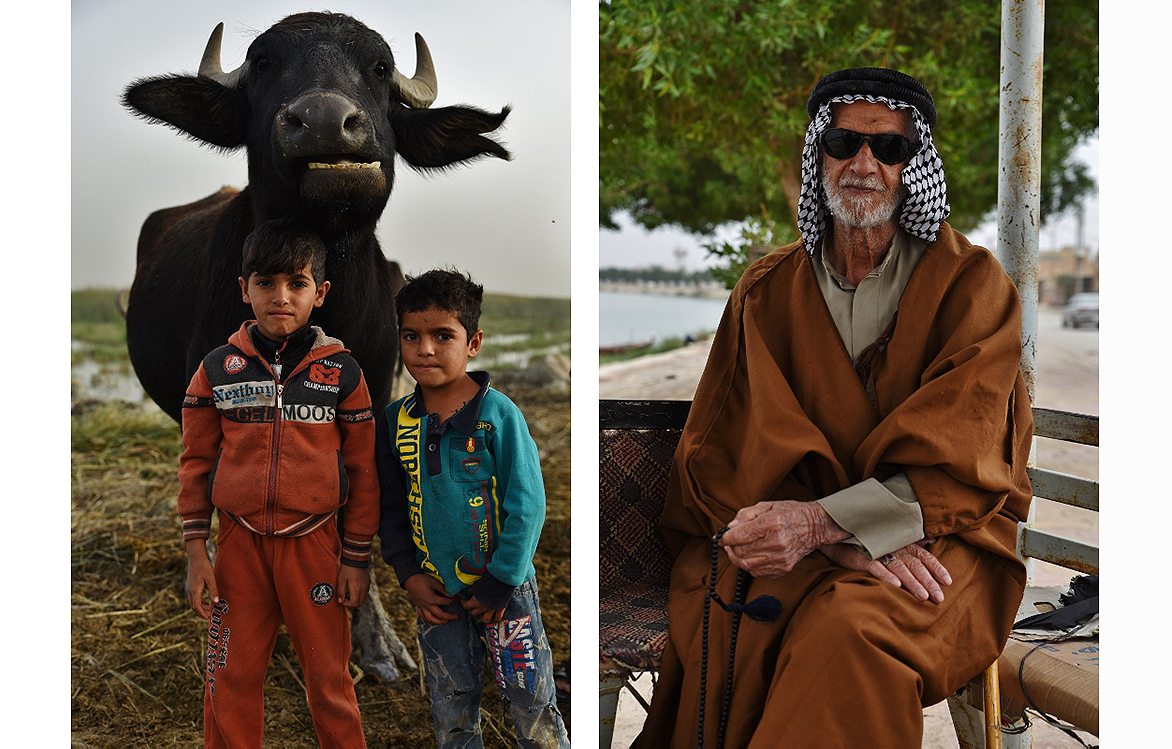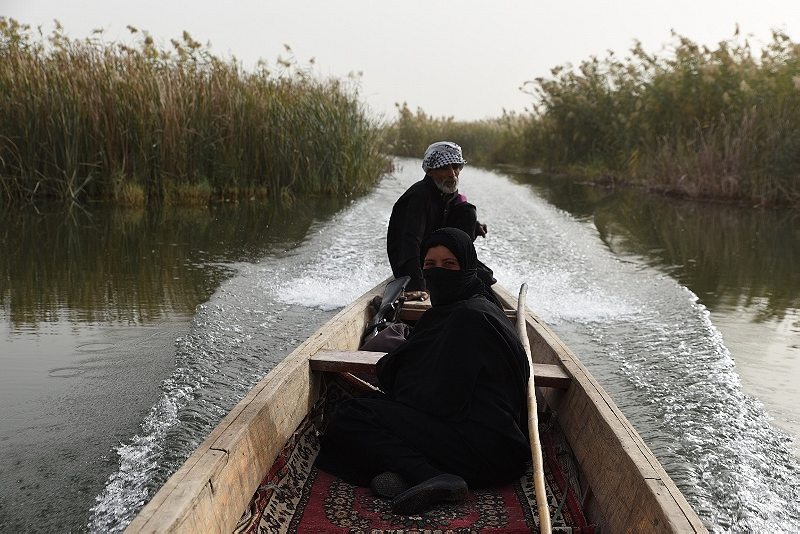Iraq’s mythical marshes survived Saddam Hussein, but can they survive climate change?
Chibayish, a small district in the Mesopotamian marshes, is a bit different from the rest of Iraq. The region, in the Shiite heartland, seems to have always stood apart, a haven in a war-torn country, an oasis in the desert.
I learned about the Mesopotamian marshes while living in Kurdistan, in northern Iraq. When I decided to head south, most of my Kurdish friends didn’t really see the point. Most of them didn’t even know the marshes existed.
These marshes are a mythical place. The Bible locates the Garden of Eden here. Many scholars describe it as the cradle of civilization. It’s the place where the Tigris and Euphrates rivers meet and divide into dozens of channels before flowing into the Persian Gulf.
I flew to Basra, Iraq’s second largest city. The name evokes images of the 2003 U.S.-led invasion. Today, Basra is run by the powerful Hashd al-Shaabi, the Shiite popular mobilization units that serve as an umbrella organization for disparate groups like the Badr and Hezbollah. In Basra, a local friend didn’t really see the point of going to the marshes either. “What is there to see up there?” he asked as we ate baklava.
The Mesopotamian marshes are made up of three separate marshes: the al-Hammar, the al-Hawizeh, and the Central marsh, where Chibayish is located, right on the bank of the Euphrates. Iraq’s marshes used to be a tourist hotspot in the 1970s and the 80s. Domestic and foreign visitors would come to observe the rich wildlife: dozens of species of birds, foxes, and lions. They’d visit the neighboring Sumerian archeological sites, and enjoy the relatively cool weather. The area—up to nearly 8,000 square miles of water, reeds, and islands—is inhabited by the Ma’dan, known as the Marsh Arabs.
To flush out the guerrillas and punish the tribesmen who had helped them, Hussein drained the marshes

But that was before. In the 1990s, everything changed. Following the first Gulf War, the area became a refuge for Shiite rebel groups hiding after the uprising against Saddam Hussein. To flush out the guerrillas and punish the tribesmen who had helped them, the dictator drained the marshes. By the end of 1991, the Iraqi army had started to destroy villages and remove inhabitants. The regime built dikes, soil embankments, and canals to divert water and prevent it from going into the marshes. The oasis became a desert.
In total, almost half a million people were displaced to Iran and elsewhere; just 20,000 people remained in the region. And, within a few months, the marshes disappeared almost completely. Landmines were planted and the waterways were poisoned with chemicals.
In 2003, Hussein’s regime fell following the U.S.-led invasion of Iraq. During the wartime chaos, the Marsh Arabs returned to their homeland and destroyed the dams and dikes Hussein had built to block the rivers. “It was a spontaneous thing everyone participated because people knew the marshes their whole life,” says Jasim al-Asadi, a local engineer working with the non-governmental organization Nature Iraq to protect the marshes. Water returned to the marshes. Within a few months, plants began to grow again.

Hana, who didn’t want to give her last name, lives deep in the Central marsh in a reed house. The floor is covered with flowery carpets. Hana is only 27 but looks much older. The skin around her bronze-green eyes has already wrinkled. She wears a long black dress and her black hijab is loose.
Hana has been wearing black since the beginning of Muharram, the Shiite month of mourning. But it’s over and tomorrow she will wear red or blue she says, smiling. When she goes to the town of Chibayish, which is 30 minutes away by boat she will put on a black abaya. The dress codes are more conservative there.
But even Chibayish itself is like a little haven. There is no threat from ISIS here, and also, no Shiite Islamist militias. They run the region, but leave Chibayish and the Central Marsh alone. People in town say it is thanks to the authority—both symbolic and real—of the Beni Asad tribe, one the most powerful tribes of the region.

I meet the tribe’s leader, Sheikh Loubnan Abdulrazaq Al-Khaiwan, on a rainy morning. He is sitting in his mudhif, a beautiful common house entirely built with reeds. “We have no conflict here because of the way society is made,” says the Sheikh. “The tribes have good relationships between each other, so people respect the law.”
Still, even without war, this haven is threatened and could disappear again. Even without dams and dikes, the marshes could dry out. Since people started moving back in 2003, the marshes have twice shrunk to almost nothing: once in 2008 and again in 2015.
There are several causes. Climate change is causing hotter summers: 130 degrees days are not unusual in this part of Iraq, which has intensified water evaporation. Iraq’s water policy, prioritizing agriculture over environmental concerns and allocating most water to wasteful, intensive irrigation practices is depleting resources. “Cronyism is also an issue,” says a local activist who did not want to be named. “If the Minister of Water Resources is, for example, from Najaf, then he will give a lot of water to Najaf and nothing to us.”

But the biggest threat comes from further upstream. The headwaters of both the Tigris and the Euphrates are in Turkey. The waters flow from Turkey through Syria and, finally, into Iraq. “When they let the river flow, we have water. When they don’t, we don’t have water,” says the Sheikh.
There are agreements about how the resource is shared. “But Turkey doesn’t respect them,” says al-Asadi. Turkey has long been building dams upriver, especially on the Tigris. The most recent project, the contentious Ileus dam in southeast Turkey, will be operational by the end of 2017 and will dramatically reduce the flow of the river.
Moreover, a new actor has made an appearance in 2014. “The 2015 drought was worsened because ISIS had control over dams on the Euphrates in Ramadi and Fallujah,” says al-Asadi. In the summer of 2015, the jihadist organization closed the gates of the dam in Ramadi, lowering the level of the river. ISIS has since lost control of Ramadi and Fallujah but still controls Syria’s biggest dam on the Euphrates, the Tabqa dam, near Raqqa.

The water is not only scarce, it is also too salty, says al-Asadi. “There is less water, it evaporates more and it doesn’t flow, so the salinity level is increasing.” Before Saddam drained the marshes, the salinity level wouldn’t go above 200 parts per million (ppm). Today, 2,500 ppm is considered acceptable. In 2015, it went up to 20,000 ppm in some areas of the marshes, says the engineer.
That year, the Ma’dan buffalo breeders lost around a third of their livestock and had to sell more animals in order to buy grass and drinkable water for the remaining ones. Ali Murad Hassan, a farmer, lost 15 buffalo. “They just drank the water and died,” he explains, as we drink hot buffalo milk in his reed house.
Hassan has six children. “It’s not that many,” he laughs with obvious pride. He decided to stay in the marshes despite the droughts, the difficult living conditions, the lack of electricity and running water. Despite the searing heat in summer and the wet, cold weather in winter. Despite the fact that there are no schools in the marsh and that his older daughter, Inas, who is around 10, can’t read nor write. If things really get bad, he may go to another part of the marsh, he says. Many have done that. Some even moved to the suburbs of Chibayish, the nearest small town. But until he is really forced to do so, he will stay.